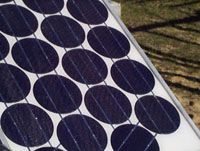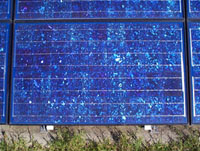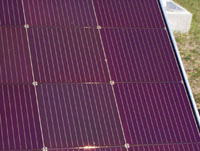
Different Types of Cell
Single crystal cells
These are made by taking slices from a large crystal ingot which has been grown at around 1400 oC. The silicon must be of a very high purity and the cell must have a near perfect crystal structure. This makes it a very expensive process. The slices can now be made as thin as 200 microns. Research cells have reached 24% efficiency and commercial modules of single crystal cells have exceeded 15%.

Image taken from: http://acre.murdoch.edu.au/refiles/pv/text.html without permission
Polycrystalline Cells
These cells are made by a casting process; molten silicon is poured into a mould and allowed to set. The cast is then sliced into wafers. These cells are much cheaper to produce than single crystal cells but are also less efficient. The loss of efficiency is due to imperfections which occur from the casting process. Research cells have achieved 18% efficiency and commercial modules 14% In both this process and single crystal formation, about half of the silicon is lost as dust in the slicing process.

Image taken from: http://acre.murdoch.edu.au/refiles/pv/text.html without permission
Thin-film cells
These cells are made by depositing silicon (from a reactive gas such as silane) onto a substrate such as glass or plastic. Amorphous silicon cells are made by depositing silicon onto a glass substrate.

Image taken from: http://acre.murdoch.edu.au/refiles/pv/text.html without permission
Amorphous silicon is used in thin films in consumer products such as watches and calculators. One of the current problems with amorphous silicon is the low efficiency and therefore greater space needed. There are many other types of thin film technology such as multicrystalline silicon, cadmium telluride and gallium arsenide cells. Thin film cells offer many advantages over the other types of cell such as ease of deposition, ease of mass production, suitability to large scale uses and the ability for the silicon to be deposited on inexpensive substrates.
The finished product
Before a cell can be used it needs several other finishing touches. Silicon is naturally very reflective, so an anti-reflective coating is applied to the cell. This can reduce losses in reflection down to 5%. A glass cover is also usually applied. Modules of cells are also often made by connecting many cells (often 36) in series and parallel to get useful levels of voltage and current output.